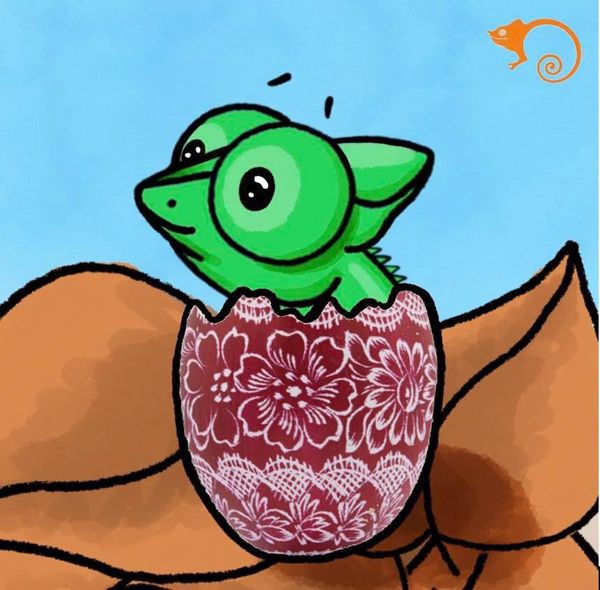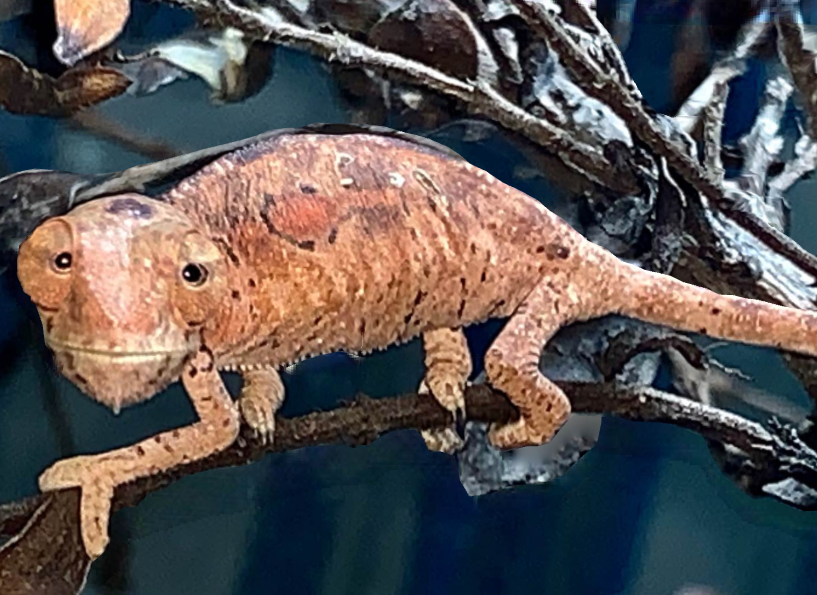Chameleon Minuta

Trioceros sp., an undescribed form from the Samburu country, Kenya

Malagassy Furcifer pardalis have often well visible susbcutaneous parasites - Filaria worms

Males of Trioceros werneri from Rubeho Mts have impressive red horns and occipital flaps

Chameleons are not commonly depicted in ancient mosaics, as they were not typically a central theme in ancient art. However, there are a few examples of mosaics where chameleons are portrayed.One of them is Zeus and Ganymede mosaic, Metropolitan Museum of Art, NYC.

Kinyongia artytor, one of the most colorful chameleons at all

HOW LONG IS A CHAMELEON'S TONGUE AND HOW DOES IT WORK?
https://ipardalis.com/how-long-is-a-chameleons-tongue/...
Foto courtesy Jonathan Hill

Chamaeleo laevigatus from the Murchison Falls NP, W Uganda is living in high grass
Foto courtesy David Modry

Respiratory infection - typical posture

The Ambilobe Panther Chameleon is one of the most variable local forms… Enjoy the two extremes: extremely high blue colorful male YBRB and a very rare lime yellow female while shedding and with nicely visible subcutaneous Filaria worms
https://youtu.be/l7St_AZ4VmM?si=SIE9Af11FPN8EsiS<br>
The Responsible Herpetoculture Project of BION Terrarium Centre.

Atypically yellow coloured female of Furcifer pardalis from Ambilobe shedding in pieces
The Responsible Herpetoculture Project of BION Terrarium Centre.

Knysna Dwarf Chameleon,
Bradypodion damaranum, RSA
is indeed one of the most colorful chameleons at all…

Trioceros quadricornis, The Four Horned Chameleon from Cameroon with an impressive head ornamentation

There is hardly anything more cute than new life…
A young Panther Chameleon, Furcifer pardalis from Nosy Faly, Madagascar

The name Godfather was "awarded" to me independently many times over years from both breeders as well as scientists...
I use it as a light metaphoric expression depicting my mission: caring for chameleons, protecting them and making their lives in captivity better... In parallell, I was the one who introduced the Yemen chameleon (and several other species) on a wide scale into captivity, so, I feel responsible for them, as most of the captive Yemen chameleons are the descendants of my original breeding stock. There is no other meaning in the name Godfather, it expresses humility and responsibility, not pride.
Playing with black light while taking photos of chameleons delivers some
unnatural but esthetically very impressive patterns and colorations...
Egg-tooth...
To hatch, the young chameleon needs to cut the egg shell to be able to get out of the egg. It is a very sharp microscopical structure sized even just for cutting the egg shell... It falls off after the hatch.
It very rare to record it, this is one of the rare occasions to see it...
Trioceros fuelleborni is quite rarely seen nowadays in captivity as Tamzania banned all
Exports if wildlife years ago.
The more, the a solute cuteness of babies born in captivity is even more valuable in F5...
Unbeatable Occipital Flaps
The socotran Monk Chameleon, Chamaeleo monachus using the occipital flaps for intimidation of another male, predator and imposing a female
Trioceros deremensis from Tanzania is a majestic species...
Kinyongia matschiei, a Monkey Tail Chameleon
One of the fantastic creatures from Tanzania with an extremely long tail, which is actually typical for all representatives of the genus Kinyongia...
Got bitten by a wild chameleon?
Well, they do habe sharp teeth
Well, they fight for their life
Just be careful and do not harm yiurself
And do not harm the chameleon :-)
The Rhinoceros Chameleon, Furcifer rhinoceratus, Ankarafantsika, W Madagascar.
The Responsible Herpetoculture Project of BION Terrarium Centre.
First translucent Panther Chameleon in history...
REAL ANKIFY Panther Chameleons...
Especially last time, as Ankify, Ambanja Panthers are very often mislabelled. This leads to genetic pollution and damage of pure breeding lines. 1
Enjoy few pics of real Ankify Panthers photographed.
In the wild...
Nosy Faly Panther Chameleons: The True Natural Appearance
In captivity, thanks to the following factors, this local from is often discussed and looks nowadays very different from the wild appearance:
1. Not sure origin of WC, especially of females that are often mixed up and are unidentifiable
2. Untrue information given by importers, flippers and not trustful breeders either as a lie or based on lack of true info
3. Crossbreeding with other local forms either deliberately (for morecolors or "better" look in seek for higher price)
4. Selective line-breeding for fixing a desired treat
5. Inbreeding either deliberate (for seek of mutations or quick fixing a desired treat) ot due to limited breeding stock
The depicted animals are WNC (Wild, Not Caught), photographed IN 2013 on Nosy Faly by Katrin Pawlik, erkin: FRG (thank you for sharing!)
Fantastic Florida Wild Feral Yemen Chameleons
The amazing beauty of chameleon tails...
Chamaeleo monachus from the Island of the Dragonblodtree: Socotra
This beauty is extremely rare and has been reproduced in captivity only once...
Nothing is more exciting and gentle and fascinating and cute and positive than a new life emerging...
Trioceros tempeli, one of the really spectacular species from Tanzania wears a unique double gular crest...
A bite from a wild chameleon can be quite painful Chameleo monachus, Socotra
The Socotra, an island of unbelieveable beauty and uniquenness is home to many plant and animal species, Found nowhere else in the world.
It is also home of a unique chameleon species, reaching almost 50cm in total length
Chamaeleo monachus, the Monk chameleon.
The giant chameleon, Furcifer oustaleti just few kilometers from Antananarivo.
The Responsible Herpetoculture Project of BION Terrarium Centre.
My birthday present 1: an awesome Furcifer pardalis from Ankaramy.
The Responsible Herpetoculture Project of BION Terrarium Centre.
Ambanja Panther Chameleon in the wild
The Responsible Herpetoculture Project of BION Terrarium Centre.

Furcifer pardalis, Ambilobe
A very colorful morph from NW Msdagascar
The Responsible Herpetoculture Project of BION Terrarium Centre.
The Lichtenstein Post has issued a new postal stamp depicting Chamaeleo monachus from Socotra. The pic originates from our expedition to Socotra in October 2019. :-)
Trioceros Jacksonii Xantholophus "Three-Horned" Female
While in this form the females appear hornless, in some specimens we can find tiny pointed scales exactly at places, where in males, mighty three horns grow...

Calumma crypticum
For more than a century, it was an unrecognized species, the specimens of it were referred to Calumma brevicorne, described in 1879 by GÜNTHER. In the 90s we already new they are different: we called them "the blue-legged Calumma brevicorne"...
Then, they were described as Calumma crypticum (the hidden, unknown Calumma) by RAXWORTHY & NUSSBAUM in 2006...

1. Straight or only slightly bent
2. Thin, not puffy
3. Intact, no burns or injuries
The colorful Jackson's Chameleon from Machakos, Central Kenya
It would be maybe useful to know how a typical T. hoehnelii biotope looks like...
Central Kenya, 2500m a.s.l.
Why It Is NOT Good To Transport Chameleons In Cotton Bags
There are many risks of transporting chameleons bags, everyone should absconding from doing so.
The most important argument are the bad, often unhealable injuries of the mouth tip, resulting in stress, refusal to eat, often in mouth rot and subsequent death.

Trioceros narraioca from Mr. Kulal, N Kenya is one of the few species that did not change their name while being described and named in Latin: In Samburu language, spoken in the inhabited area of this species, the word "chameleon" is pronounced as "narraioca"

A very rare chameleon, Trioceros harennae from the Harenna Forest, southern slopes of Bale Mts, Ethiopia

Rhampholeon nchisiensis from western Tanzania
Fog hydrating of chameleons in Morocco. The atlantic coast is quite mild in climate and the fog hydrates the chameleons here...

The second for science known specimen of Trioceros conirostratus, Loita Hills, N Kenya
How do the real Nosy Be Panther chameleons, Furcifer pardalis look like in reality?
There are true blue Nosy Be panthers considered the natural and most desired color form from this island. The fact is, they are quite variable and the blue phase is peesent but quite rare and not only one...
Enjoy a little selection.
The Responsible Herpetoculture Project of BION Terrarium Centre.
Furcifer oustaleti, Ankarafantsika, Madagascar
The Responsible Herpetoculture Project of BION Terrarium Centre.

My birthday present 2: an awesome Furcifer pardalis from Ambanja
The Responsible Herpetoculture Project of BION Terrarium Centre

Males od Ambilobe Panther Chameleons are real jewels...
The Responsible Herpetoculture Project of BION Terrarium Centre.
Calumma lionotum from Montaigne de Ambre, NW Madagascar is a locally abundant, though quite rare chameleon species with well developped sexual dimorphism... Despite of tiny size and graceful appearance, they live at considerably high altitude around 1000m a.s.l. in quite cold, foggy & misty and windy biotopes.
Winner: Colorful
Loser: Black
Males of the Johnston's Chameleon may fight: the result is visible notnin blood and scars but in colors...
Happy Easter!

Ticks on chameleons are extemely rare
Chameleons are notoriously known for internal parasites, but reports on external parasites are mostly referring to mites. Here, evidence of ticks (Acarina) in Chamaeleo arabicus from Oman. One still almost empty, second full of chameleon's blood already.
Beginning of shedding
The beginning of shedding might look very strange in some species, sometimes it looks quite unnatural and an inexperiemced keeper might even want to run to a VET.
Here, a female of the Natal Midlands Chameleon, Bradypodion thamnobates.
Furcifer pardalis, Nosy Faly
HOPE FOR THE FUTURE
It is well known, this local form is extinct now. Driven by the greed of local animal collectors who thought it will be a big business, they took several females from Nosy Be and Ambanja areas and dropped them on the island. They forever damaged the genetics of this local form which disappeared from the tiny island of Nosy Faly.
Few pure bloods are still remaining in captivity:
I hope these will be a part of a Local Form Captive Conservation Programme, as this is the only chamce of these beautiful panthers with lots of white and red rain to survive for future generations…
What a joy to see the first steps of a less than 2 cm long Brookesia thieli in this world…

Hatched and growing…
Here, a baby of Furcifes pardalis, local form Nossy Mitsio.
…and heavenly cute

Chameleons are usually feared and connected with superstitions and legends. After a little education, even a mother from Meru, Kenya, handles with respect but smile an adult Muriyu

Chamaeleo arabicus with dew collected on his head and body during a foggy night. The skin of the chameleons is however impenetrable for water, so they must gain water through the unique mechanism: dew-drinking
Author: Petr Nečas